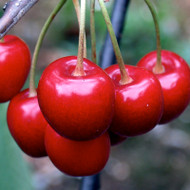Types: Sweet, Acid, Duke, Mazzard:
Acid cherries are the fruit of Prunus cerasus - thought to be a naturally occurring hybrid between two other Prunus species, which has then been selected and bred from over the past 2000 years. They were certainly grown by the Greeks and Persians, and like a lot of fruit were introduced into the U.K. by the Romans. They became a very popular crop, especially in Kent where they flourished in the chalk soils and enjoyed proximity to the London market. Up until 1930 there were over 50 types of sour cherry in cultivation - such as ‘Kentish Red’, ‘Amarelles’ and ‘Flemish’. These days you will be lucky to find three varieties for sale - the ubiquitous Morello, the German variety Rheinisches Schattenmorrelo’ and the newer ’Nabella’.
Duke cherries are the result of crossing acid cherries with sweet cherries (Prunus x gondouinii.) this was carried out several hundred years ago, and for a while Duke cherries were the most popular cherries in England. They are hardier and more disease-resistant than most sweet cherries, and although the crop is slightly less heavy than a true acid cherry, the flavour more than makes up for it. Partially self-fertile, the crop will be much heavier if there is another cherry of any type nearby to help with pollination.
The most popular of the cherry types for growing at home these days is undoubtedly the sweet cherry. The past 50 years have seen huge advancements in both rootstock development and variety choice, so where once it was only possible if you had enough space for two 10m tall trees, now you can taste your own home-grown cherries in a normal garden, allotment or even in a pot on a patio. The most dwarfing rootstock is Gisela 5 (or the slightly more vigorous Gisela 6), which is good if space is really tight, but the tree will need deep fertile soil and a sheltered position to do well. Colt is more vigorous, but will tolerate a wider range of soils and colder, more exposed sites.
Mazzard cherries are a particular group of traditional West Country varieties which have been selected from the wild cherry (Prunus avium) over several centuries. Taste-wise, they probably most closely resemble the duke cherries, tart and a little astringent, but with plenty of sugar when fully ripe. The main advantage of these is that they thrive in a damp climate, so for areas of high rainfall these are perfect. Disease-resistant and hardy, these make super specimen trees if you have the room.
Pruning:
Sweet, acid and duke cherries are all different species, and produce their fruit in slightly different parts of the tree - you need to bear this in mind when pruning, as it is not the same for all three.
Sweet cherries (and Duke cherries) produce all their fruit at the base of one year old wood, and on older wood. Thus you can prune a lot of new growth back in the middle of summer, and still leave plenty of potential for fruit in the subsequent year.
Acid cherries, on the other hand, produce all the fruit on one year old wood. If you give the tree and all over ‘haircut’ this summer, you will severely limit the potential for fruit next year. instead use a renewal pruning method, pruning back a third of the branches which have born fruit this summer, back to a replacement bud lower down the branch. Leave any other growth untouched, which will be where next summer’s crop will emerge. This way two-thirds of the tree will always be fruitful, whilst the other third is renewing.
For all cherries, the golden rule is to only prune in the summer months. All members of the Prunus family are susceptible to bacterial canker, which is born on winter rains and enters the tree via open pruning cuts and wounds. If you prune in summer (and seal any major cuts), the cuts will have time to heal over before winter arrives.
Cherries can also tend to grow more upright than some other stone fruit - the fruit doesn’t tend to weight the branches down as it can do with plums and gages - so pay particular attention to pruning to a bud on the underside of the branch to encourage more productive horizontal growth. You should also remove any strong vertical growth, as this can break and split in later years.
Recommended Varieties:
May Duke. Just about the only Duke cherry still available, this produces fruit with a delicious mix of sugar and acidity.
Cherokee. Also known as Lapin's Cherry, this was one of the first self-fertile sweet cherries to be developed, and is still a fantastic choice. Developed in British Columbia at the Pacific Agri-Food Research Centre, it was a result of crossing the Van cherry variety with Stella. The result is superb, producing dark, large sweet fruit which are firm and resistant to splitting.
Sunburst. Another self-fertile variety from the Canadian breeding programme, but this one has dark red, almost black fruit. The cherries are large, it’s a good cropper and the flavour is wonderful. It can be prone to fruit splitting though, so a good mulch is essential to keep moisture levels even and reduce the potential for this to happen.
Bigarreau Napoleon. This is one of the oldest varieties you will find offered for sale - it originated in Germany over three hundred years ago, but was renamed after the famous French emperor in 1820. It is one of the original bigarreau or firm-fleshed varieties. The yellow fruit, with a soft red flush have a sumptuously sweet flavour that few of the modern varieties can match. It is trickier to grow however - susceptible to both canker and fruit split, it needs a deep, fertile soil to prosper and a pollinating partner. If you can give it the care it requires, the rewards are more than worth it.

